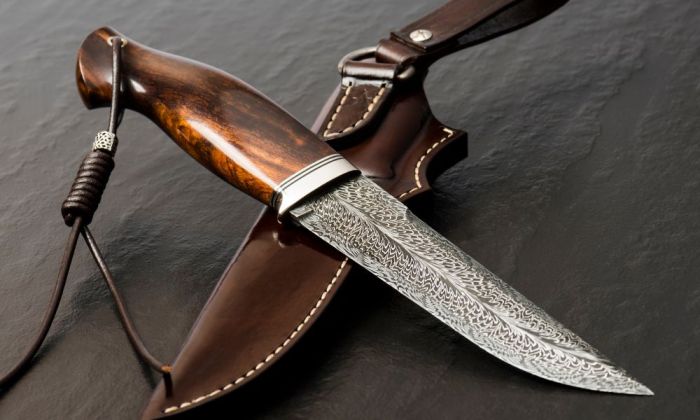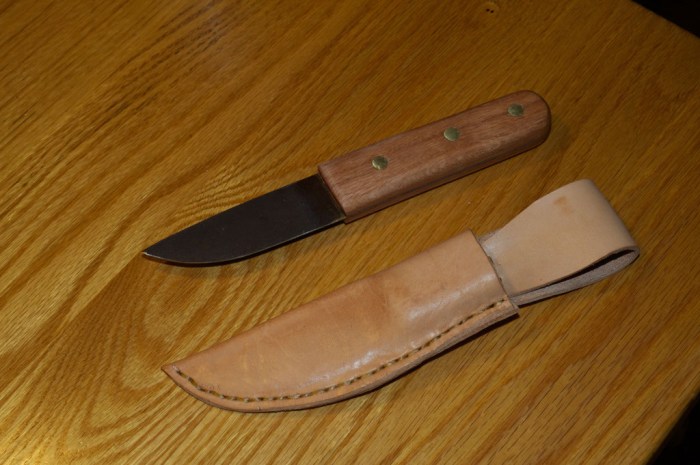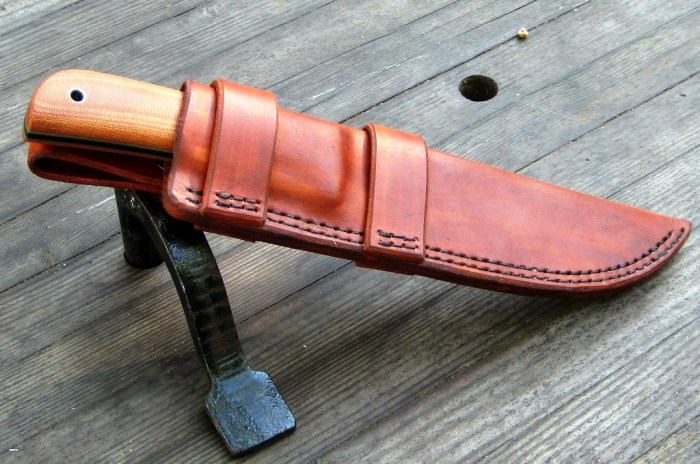DIY Knife Sheath: Embark on a journey into the world of crafting your own custom knife sheath. Whether you’re a seasoned outdoorsman or a budding DIY enthusiast, this guide will equip you with the knowledge and techniques to create a functional and stylish sheath that perfectly complements your favorite blade.
Table of Contents
From selecting the right materials and tools to mastering basic construction techniques, we’ll explore the intricacies of crafting a DIY knife sheath that meets your specific needs and preferences. We’ll also delve into advanced design features, safety considerations, and customization options, allowing you to personalize your sheath and make it truly your own.
Essential Tools and Materials
Creating a DIY knife sheath requires a few essential tools and materials to ensure a secure and functional outcome. This section will provide a comprehensive overview of the tools and materials needed, their purpose, and examples of commonly used brands.
Cutting Tools
Cutting tools are crucial for shaping and trimming the materials used for the sheath.
- Utility Knife: Used for precise cutting and shaping of leather, fabric, and other materials. Popular brands include Olfa, X-ACTO, and Stanley.
- Leather Punch: Creates holes for stitching and attaching hardware. Examples include Craftool, Weaver Leather, and Tandy Leather.
- Rotary Cutter: Ideal for cutting large pieces of leather quickly and efficiently. Popular brands include Olfa, Fiskars, and Clover.
- Scissors: Used for general cutting tasks, especially for fabric and thin materials. Popular brands include Fiskars, Washi, and Westcott.
Stitching Tools
Stitching is essential for creating a durable and secure sheath.
- Sewing Needle: Used for hand-stitching leather and fabric. Choose needles with a strong, sharp point suitable for the thickness of the material. Examples include John James, Prym, and Clover.
- Stitching Awl: Creates holes in leather for stitching, making it easier to pass the needle through. Popular brands include Craftool, Weaver Leather, and Tandy Leather.
- Sewing Thread: Durable thread specifically designed for leather and fabric. Popular brands include Tiger Thread, Ritza Tiger, and Gütermann.
- Stitching Pony: A tool that holds the leather securely while stitching, ensuring even tension and consistent stitches. Popular brands include Craftool, Weaver Leather, and Tandy Leather.
Adhesives
Adhesives are used to bond different materials together and create a strong, secure sheath.
- Leather Cement: A strong adhesive specifically designed for bonding leather. Popular brands include Barge Cement, Leathercraft Contact Cement, and Loctite Super Glue.
- Fabric Glue: Used for bonding fabric to leather or other materials. Popular brands include Aleene’s Tacky Glue, Beacon Fabric Glue, and Elmer’s Fabric Glue.
Other Essential Materials
Other materials are needed for the construction of the sheath.
- Leather: The primary material for the sheath. Choose a thick, durable leather that is suitable for the size and weight of the knife. Popular types include veg-tan, full-grain, and top-grain leather.
- Fabric: Can be used as a lining or for decorative purposes. Popular types include canvas, nylon, and suede.
- Hardware: Includes buckles, snaps, and other attachments used to secure the sheath. Popular brands include Tandy Leather, Weaver Leather, and McMaster-Carr.
Basic Knife Sheath Construction Techniques
Creating a knife sheath is a rewarding and practical project. Whether you’re a seasoned outdoorsman or a novice crafter, understanding the fundamental techniques will enable you to craft a secure and durable sheath for your favorite knife.
Basic Knife Sheath Construction Techniques
The process of constructing a basic knife sheath involves several key steps:
- Pattern Creation: The first step is to create a pattern for your sheath. This pattern will serve as a template for cutting the chosen material.
- Material Selection and Preparation: The choice of material depends on your preference and the intended use of the sheath. Common materials include leather, kydex, and nylon. Before cutting, prepare the material by cleaning, smoothing, or softening it as needed.
- Cutting and Shaping: Using the pattern as a guide, carefully cut the chosen material to the desired shape. Ensure all edges are smooth and free of burrs.
- Securing the Sheath: The method of securing the sheath to the knife depends on the material and design. Common methods include stitching, riveting, or using adhesive.
- Finishing Touches: Once the sheath is secured, add any desired finishing touches such as stitching, embossing, or painting.
Advanced Knife Sheath Design and Features

Once you’ve mastered the basics of knife sheath construction, you can explore advanced features that enhance functionality, security, and style. These features can transform your sheath from a simple protective case into a sophisticated and personalized tool.
Retention Systems
Retention systems are crucial for preventing accidental knife loss. They hold the knife securely in the sheath, ensuring it stays put even during vigorous activity.
- Friction Retention: This is the simplest form of retention, relying on friction between the knife and the sheath. A tight fit, often achieved through a combination of material thickness and a snug design, creates resistance that keeps the knife in place. This method is commonly used for smaller knives and everyday carry sheaths.
- Snap Retention: This system employs a snap or button closure to secure the knife. It provides a quick and secure way to keep the knife in the sheath while allowing for easy access. Snaps can be made from various materials, including metal, plastic, and leather.
- Strap Retention: A strap, often made of leather or webbing, is used to secure the knife in the sheath. This method is versatile, allowing for different levels of retention depending on the strap’s width, material, and adjustment mechanisms.
- Locking Retention: For maximum security, locking retention systems utilize a mechanism that prevents the knife from being withdrawn without deliberate action. This can include a locking button, a spring-loaded clip, or a combination of both. These systems are ideal for high-risk situations or when carrying valuable or dangerous knives.
Belt Loops, Diy knife sheath
Belt loops are essential for attaching the sheath to a belt, allowing for convenient and secure carrying.
- Single Belt Loop: This is the simplest type of belt loop, consisting of a single loop of material that fits over a belt. It’s suitable for smaller sheaths or those that don’t require a lot of adjustment.
- Double Belt Loop: Two belt loops, often positioned at the top and bottom of the sheath, provide more stability and allow for adjustment on different belt widths.
- Adjustable Belt Loop: These loops feature a mechanism for adjusting the size, allowing for a more customized fit on various belt widths. This is particularly useful for users who wear different belts or have fluctuating waist sizes.
- MOLLE Attachment: MOLLE (Modular Lightweight Load-carrying Equipment) is a widely used system for attaching pouches and accessories to gear. Sheaths with MOLLE attachment points can be easily integrated into tactical vests, backpacks, or other MOLLE-compatible platforms.
Drainage Holes
Drainage holes are essential for preventing water from accumulating inside the sheath, especially if the knife is used in wet conditions.
- Placement: Drainage holes should be strategically placed at the bottom of the sheath to allow water to drain out. They should be sized appropriately to prevent debris from entering the sheath.
- Number: The number of drainage holes depends on the size and shape of the sheath. Larger sheaths may require multiple holes for effective drainage.
- Material: Drainage holes can be made in the sheath material itself or by using grommets or eyelets.
Examples of Innovative Design Features
- Kydex Sheaths with Integrated Belt Clips: Kydex sheaths are known for their durability and form-fitting design. Some Kydex sheaths incorporate belt clips directly into the sheath, eliminating the need for separate belt loops.
- Leather Sheaths with Adjustable Retention Straps: Leather sheaths are known for their durability and classic aesthetics. Some leather sheaths feature adjustable retention straps, allowing for a customized fit and retention level for different knives.
- Sheaths with Multi-Carry Options: Some sheaths are designed to be carried in multiple ways, including belt loops, MOLLE attachments, or even as a pocket sheath. This versatility allows for adaptability to different carrying preferences and situations.
Safety and Durability Considerations

Creating a DIY knife sheath requires careful attention to safety and durability to ensure a secure and long-lasting product. This section will delve into essential considerations for crafting a safe and durable sheath that protects both the knife and the user.
Safety Considerations
Safety is paramount when handling knives and their sheaths. Several factors must be considered to prevent accidental injuries:
- Sharp Edges: The sheath should be designed to prevent the knife from accidentally slipping out and exposing sharp edges.
- Secure Retention: The sheath must securely hold the knife in place, preventing it from falling out during movement or accidental bumps.
- Proper Fit: The sheath should fit the knife snugly but not too tightly, allowing for easy insertion and removal while maintaining a secure hold.
- Material Selection: The sheath material should be strong and durable, capable of withstanding the pressure and wear and tear associated with carrying a knife.
- Stitching and Fasteners: All stitching and fasteners used in the sheath should be strong and reliable to prevent failure under stress.
Durability Considerations
A durable sheath is essential for protecting the knife and ensuring its longevity. Here are key aspects to consider:
- Material Choice: Leather, Kydex, and ballistic nylon are common materials used for knife sheaths, each offering unique properties in terms of durability and resistance to wear and tear.
- Reinforcement: Strategic reinforcement in high-wear areas, such as the sheath’s mouth, can significantly enhance its durability.
- Stitching and Fasteners: Using high-quality stitching and robust fasteners ensures the sheath remains secure and functional for extended periods.
- Proper Care: Regular cleaning and maintenance of the sheath are crucial for preserving its durability and preventing premature wear.
Sheath Maintenance
Maintaining a DIY knife sheath is essential to prolong its lifespan and ensure its continued functionality. Here are some tips for caring for your sheath:
- Regular Cleaning: Clean the sheath regularly with a damp cloth to remove dirt, grime, and debris.
- Conditioning: Leather sheaths benefit from regular conditioning with leather oil or balm to keep them supple and prevent cracking.
- Storage: Store the sheath in a dry, well-ventilated area to prevent mold and mildew growth.
- Inspection: Regularly inspect the sheath for signs of wear and tear, such as loose stitching or cracked material, and repair any damage promptly.
Choosing the Right Knife for Your Sheath

When embarking on your DIY knife sheath journey, selecting the perfect knife is paramount. The sheath’s effectiveness and functionality hinge on the knife’s size, shape, and design. Matching the knife and sheath ensures a secure fit, optimal protection, and a harmonious aesthetic.
Matching Knife and Sheath
The knife’s size, shape, and design directly influence the sheath’s construction.
- Size: A larger knife requires a larger sheath. Consider the overall length, blade length, and handle size when choosing a sheath.
- Shape: The knife’s blade shape dictates the sheath’s profile. Curved blades often require a curved sheath, while straight blades may be accommodated by a straight sheath.
- Design: The knife’s handle design influences the sheath’s opening and retention mechanism. A handle with a pronounced guard may require a sheath with a specific opening for secure retention.
Popular Knife Types and Corresponding Sheath Designs
- Folding Knives: These knives often feature compact designs and are ideal for everyday carry. Their sheaths are typically slim and may include a belt loop or pocket clip.
- Fixed Blade Knives: Fixed blade knives are known for their durability and strength. Their sheaths are often larger and may feature a belt loop, a retention strap, or a combination of both.
- Hunting Knives: Hunting knives are designed for specific tasks, such as skinning or field dressing. Their sheaths often have a specific design to accommodate the knife’s blade shape and handle.
- Tactical Knives: Tactical knives are designed for military and law enforcement applications. Their sheaths often feature MOLLE compatibility for attachment to tactical gear.
Customizing Your DIY Knife Sheath
Beyond the basic functionality, your DIY knife sheath can be a canvas for your creativity. Personalizing your sheath adds a touch of individuality and can reflect your personality or the purpose of the knife it houses.
Adding Unique Details and Features
- Stitching: Stitching not only secures the sheath but also provides a decorative element. Experiment with different stitch patterns, thread colors, and even decorative stitching techniques like whipstitching or backstitching. Consider using contrasting thread colors for a bolder look.
- Carving: For a rustic and personalized touch, carve intricate designs or your initials into the leather. You can use a variety of carving tools, from basic leather punches to specialized carving sets.
- Painting: Add color and vibrancy to your sheath with leather paint. You can create simple designs, intricate patterns, or even paint a scene relevant to the knife’s purpose. Remember to use leather-specific paint for durability.
- Embossing: Create raised designs on the leather using a leather stamping tool. This technique adds texture and depth to your sheath.
- Adding Accessories: You can attach additional elements like belt loops, straps, or even a small pouch for carrying extra gear.
Creative and Personalized Knife Sheath Designs
- Survival Knife Sheath: A sheath for a survival knife can incorporate a fire starter, a small compass, or even a tiny survival kit attached to the sheath.
- Hunting Knife Sheath: A hunting knife sheath might feature a game carrier strap, a loop for a hunting knife sharpening tool, or a hidden compartment for a small cleaning kit.
- Pocket Knife Sheath: A sheath for a pocket knife can be embellished with your favorite design, a monogram, or a meaningful symbol.
- Custom Sheath for a Specific Occasion: You can design a sheath as a personalized gift for a special occasion, incorporating elements like the recipient’s initials, a meaningful date, or a symbol representing their interests.
Resources and Inspiration: Diy Knife Sheath
Crafting a custom knife sheath is a rewarding journey, and with the right resources and inspiration, you can elevate your skills and create truly unique pieces. This section explores valuable resources for DIY enthusiasts, showcases inspiring sheath designs, and encourages active participation in online communities.
Online Communities and Resources
Joining online communities is a fantastic way to connect with fellow knife sheath makers, exchange knowledge, and gain valuable insights.
- Knife Forums: Platforms like BladeForums and KnifeSteelnerds provide a wealth of information, discussions, and resources for all aspects of knife making, including sheath crafting.
- Leatherworking Forums: Sites dedicated to leatherworking, such as Leatherworker.net and The Leatherworker, offer specialized knowledge and techniques for crafting leather sheaths.
- YouTube Channels: Numerous channels dedicated to knife making, leatherworking, and DIY projects provide step-by-step tutorials, demonstrations, and inspiration for sheath designs.
- Online Tutorials and Pattern Templates: Websites like Etsy and Instructables host a vast collection of tutorials, patterns, and templates for various knife sheath designs, catering to different skill levels.
Inspiring Knife Sheath Designs
Exploring the work of experienced knife sheath makers can ignite your creativity and inspire your own designs.
- Traditional Sheath Styles: Classic designs, such as the “Scabbard” for swords and the “Kydex” for modern tactical knives, offer timeless elegance and functionality.
- Modern Sheath Innovations: Contemporary makers are pushing boundaries with innovative designs, incorporating materials like carbon fiber, Kydex, and G10 for durability and aesthetic appeal.
- Custom Sheaths: Experienced makers often specialize in crafting custom sheaths that perfectly complement specific knives, showcasing intricate details and personalized touches.
Sharing Knowledge and Learning from Others
Active participation in online forums and communities fosters a sense of collaboration and shared learning.
- Ask Questions: Don’t hesitate to ask for help or guidance from experienced makers. The community is a valuable resource for troubleshooting and seeking advice.
- Share Your Projects: Showcasing your work and seeking feedback from others can help you refine your skills and gain valuable insights.
- Learn from Others: Observe and learn from the techniques and designs of other makers, incorporating new ideas and approaches into your own work.
With a little patience, practice, and a touch of creativity, you can confidently embark on your DIY knife sheath journey. From choosing the right materials to mastering essential techniques, this guide provides a comprehensive foundation for creating a functional and stylish sheath that reflects your unique style and meets your specific needs. Embrace the challenge, explore the possibilities, and let your imagination guide you as you craft a sheath that becomes a treasured companion for your adventures.
Making a DIY knife sheath is a satisfying project, and it’s a great way to personalize your gear. Just like restoring your car’s headlights with a DIY solution, diy headlight restorer , you can use readily available materials to create a durable and functional sheath for your knife. With some careful planning and attention to detail, you’ll have a custom sheath that’s as unique as the knife itself.

